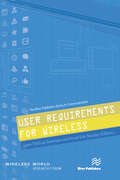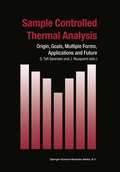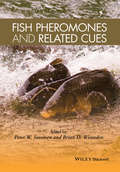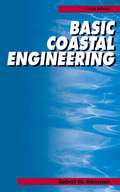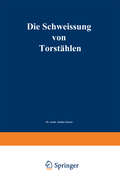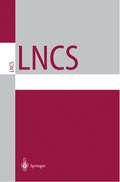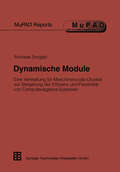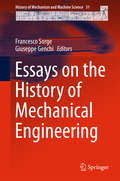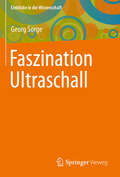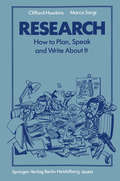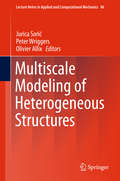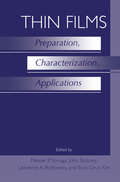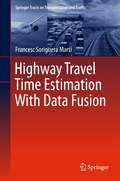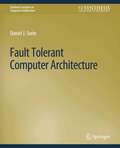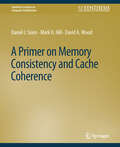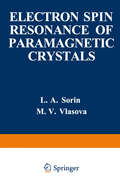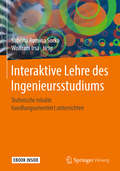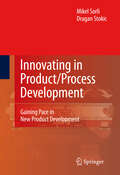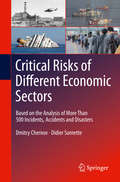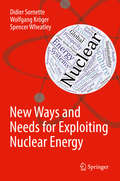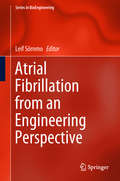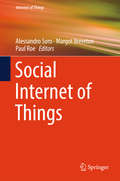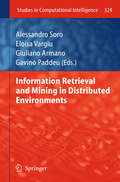- Table View
- List View
User Requirements for Wireless
by Lene Sørensen Knud Erik SkoubyIn most IT system development processes, the identification or elicitation of user requirements is recognized as a key building block. In practice, the identification of user needs and wants is a challenge and inadequate or faulty identifications in this step of an IT system development can cause huge problems with the final product. The elicitation of user requirements as such changes according to age groups;, to gender,; to cultural settings,; and into time; and experience in the use of the system/software. User requirements, therefore, cannot be used between projects, IT systems, and different software. That makes the elicitation of user requirements an inherent part of any software development project and a resourceful activity as well. This book provides insights to the process of identifying user requirements and to different types by describing varying case studies in which technologies or software has been developed. A variety of user requirements are provided illustrating the effect of changing the targeted user group with respect to age,; to the context and the different technologies or software as well as to the difference in viewpoint on ways of involving users in the elicitation process. Cases and user requirement elements discussed in the book include: • User requirements elicitation processes for children, construction workers, and farmers• User requirements for personalized services of a broadcast company• Variations in user involvement• Practical elements of user involvement and requirements elicitation• Usable security requirements for design of privacy.
User Requirements for Wireless
by Lene Tolstrup Sørensen Knud Erik SkoubyIn most IT system development processes, the identification or elicitation of user requirements is recognized as a key building block. In practice, the identification of user needs and wants is a challenge and inadequate or faulty identifications in this step of an IT system development can cause huge problems with the final product. The elicitation of user requirements as such changes according to age groups;, to gender,; to cultural settings,; and into time; and experience in the use of the system/software. User requirements, therefore, cannot be used between projects, IT systems, and different software. That makes the elicitation of user requirements an inherent part of any software development project and a resourceful activity as well. This book provides insights to the process of identifying user requirements and to different types by describing varying case studies in which technologies or software has been developed. A variety of user requirements are provided illustrating the effect of changing the targeted user group with respect to age,; to the context and the different technologies or software as well as to the difference in viewpoint on ways of involving users in the elicitation process. Cases and user requirement elements discussed in the book include: • User requirements elicitation processes for children, construction workers, and farmers• User requirements for personalized services of a broadcast company• Variations in user involvement• Practical elements of user involvement and requirements elicitation• Usable security requirements for design of privacy.
Sample Controlled Thermal Analysis: Origin, Goals, Multiple Forms, Applications and Future (Hot Topics in Thermal Analysis and Calorimetry #3)
by O. Toft Sørensen J. RouquerolSample Controlled Thermal Analysis gives a short presentation of the spirit and history of SCTA and then focuses on: basic SCTA techniques, applications of SCTA in kinetic studies and applications in the study of ceramics, adsorbents and catalysts. Finally the expected future development of SCTA is discussed. This book is an invaluable reference for materials scientists, chemists, geologists, and engineers involved in the development of new materials, the manufacturing processes and quality control. It is also useful for research in solid state chemistry, materials science, materials in general, and analytical chemistry. Producers of thermoanalytical equipment and manufacturers of catalysts, technological ceramics and adsorbents for industrial or environment applications will find this an important resource.
Fish Pheromones and Related Cues
by P. W. Sorensen Brian D. WisendenPheromones are chemical cues that pass between members of the same species that convey specific, adaptive information. These cues, and related chemicals whose function are less well defined, are especially important to fishes because of their aquatic environments and complex behaviors. Pheromones are also of increasing interest in both basic and applied aspects of fish biology because they can be used to manipulate fish behavior and may explain phenomena such as fishery collapse. Fish Pheromones and Related Cues provides a timely synthesis of this growing body of research in freshwater and marine species and explores everything from how these chemical signals evolved, are produced, released and then processed, and finally to potential applications in fish culture and conservation. Fish Pheromones and Related Cues opens with a useful overview on the theory of chemical communication and definitions. Chapters then progress by examining the biological importance of pheromones in inter- and intra-species communication, the role these chemical cues play in a variety biological functions from reproduction to predation, and then how they evolved and are detected and recognized by fish nervous systems. Final chapters provide valuable insight into how pheromones can be measured, how pheromonal disruption can explain effects of environmental pollution, and lastly how they pheromones are being applied in real-world efforts to culture fish species and to conserve our wild populations and control invasive species. With far-reaching economic, evolutionary and ecological implications, Fish Pheromones and Related Cues will be an essential volume for anyone working in the fields of chemical communication, fish biology, fisheries science, aquatic conservation, ecology, invasive species control, and aquaculture
Fish Pheromones and Related Cues
by Peter W. Sorensen Brian D. WisendenPheromones are chemical cues that pass between members of the same species that convey specific, adaptive information. These cues, and related chemicals whose function are less well defined, are especially important to fishes because of their aquatic environments and complex behaviors. Pheromones are also of increasing interest in both basic and applied aspects of fish biology because they can be used to manipulate fish behavior and may explain phenomena such as fishery collapse. Fish Pheromones and Related Cues provides a timely synthesis of this growing body of research in freshwater and marine species and explores everything from how these chemical signals evolved, are produced, released and then processed, and finally to potential applications in fish culture and conservation. Fish Pheromones and Related Cues opens with a useful overview on the theory of chemical communication and definitions. Chapters then progress by examining the biological importance of pheromones in inter- and intra-species communication, the role these chemical cues play in a variety biological functions from reproduction to predation, and then how they evolved and are detected and recognized by fish nervous systems. Final chapters provide valuable insight into how pheromones can be measured, how pheromonal disruption can explain effects of environmental pollution, and lastly how they pheromones are being applied in real-world efforts to culture fish species and to conserve our wild populations and control invasive species. With far-reaching economic, evolutionary and ecological implications, Fish Pheromones and Related Cues will be an essential volume for anyone working in the fields of chemical communication, fish biology, fisheries science, aquatic conservation, ecology, invasive species control, and aquaculture
Basic Coastal Engineering
by Robert M. SorensenThe second edition (1997) of this text was a completely rewritten version of the original text Basic Coastal Engineering published in 1978. This third edition makes several corrections, improvements and additions to the second edition. Basic Coastal Engineering is an introductory text on wave mechanics and coastal processes along with fundamentals that underline the practice of coastal engineering. This book was written for a senior or first postgraduate course in coastal engineering. It is also suitable for self study by anyone having a basic engineering or physical science background. The level of coverage does not require a math or fluid mechanics background beyond that presented in a typical undergraduate civil or mechanical engineering curriculum. The material p- sented in this text is based on the author’s lecture notes from a one-semester course at Virginia Polytechnic Institute, Texas A&M University, and George Washington University, and a senior elective course at Lehigh University. The text contains examples to demonstrate the various analysis techniques that are presented and each chapter (except the first and last) has a collection of problems for the reader to solve that further demonstrate and expand upon the text material. Chapter 1 briefly describes the coastal environment and introduces the re- tively new field of coastal engineering. Chapter 2 describes the two-dimensional characteristics of surface waves and presents the small-amplitude wave theory to support this description.
Applied Parallel Computing. New Paradigms for HPC in Industry and Academia: 5th International Workshop, PARA 2000 Bergen, Norway, June 18-20, 2000 Proceedings (Lecture Notes in Computer Science #1947)
by Tor Sorevik Fredrik Manne Randi Moe Assefaw H. GebremedhinThe papers in this volume were presented at PARA 2000, the Fifth International Workshop on Applied Parallel Computing. PARA 2000 was held in Bergen, Norway, June 18-21, 2000. The workshop was organized by Parallab and the Department of Informatics at the University of Bergen. The general theme for PARA 2000 was New paradigms for HPC in industry and academia focusing on: { High-performance computing applications in academia and industry, { The use of Java in high-performance computing, { Grid and Meta computing, { Directions in high-performance computing and networking, { Education in Computational Science. The workshop included 9 invited presentations and 39 contributed pres- tations. The PARA 2000 meeting began with a one-day tutorial on OpenMP programming led by Timothy Mattson. This was followed by a three-day wor- hop. The rst three PARA workshops were held at the Technical University of Denmark (DTU), Lyngby (1994, 1995, and 1996). Following PARA’96, an - ternational steering committee for the PARA meetings was appointed and the committee decided that a workshop should take place every second year in one of the Nordic countries. The 1998 workshop was held at Ume a University, Sweden. One important aim of these workshops is to strengthen the ties between HPC centers, academia, and industry in the Nordic countries as well as worldwide. The University of Bergen organized the 2000 workshop and the next workshop in the year 2002 will take place at the Helsinki University of Technology, Espoo, Finland.
Dynamische Module: Eine Verwaltung für Maschinencode-Objekte zur Steigerung der Effizienz und Flexibilität von Computeralgebra-Systemen (MuPad Reports)
by Andreas SorgatzEssays on the History of Mechanical Engineering (History of Mechanism and Machine Science #31)
by Francesco Sorge Giuseppe GenchiThis book treats several subjects from the History of Mechanism and Machine Science, and also contains an illustrative presentation of the Museum of Engines and Mechanisms of the University of Palermo, Italy, which houses a collection of various pieces of machinery from the last 150 years.The various sections deal with some eminent scientists of the past, with the history of industrial installations, machinery and transport, with the human inventiveness for mechanical and scientific devices, and with robots and human-driven automata. All chapters have been written by experts in their fields. The volume shows a wide-ranging panorama on the historical progress of scientific and technical knowledge in the past centuries. It will stimulate new research and ideas for those involved in the history of Science and Technology.
Faszination Ultraschall (Einblicke in die Wissenschaft)
by Georg SorgeWas haben der Untergang der Titanic, das Flugverhalten von Fledermäusen und der Verschnitt von Weinen mit Ultraschall zu tun? Auf solche und ähnliche Fragen werden in diesem Buch allgemein verständliche Antworten gegeben. Das thematische Spektrum reicht von den physikalischen Grundlagen des Ultraschalls über unterschiedlichste Anwendungs- und Einsatzgebiete bis hin zu Beispielen aus der Natur.
Research: How to Plan, Speak and Write About It
by Marco Sorgi Clifford HawkinsTraining for research is only available in a few places in the world, so that usually the researcher has to learn to master every step by himself. This entails planning the research, finding out how to obtain funds, searching the literature, analysing the data statistically, preparing visual material and slides, speaking about it in public, writing it up for journals and so on. Books on various aspects of this subject are readily obtain able but this is an attempt to deal with all the steps that are necessary from the start to the finish, and chapters have been planned sequentially with this in mind. Although most of the authors are doctors of medicine, it should help those in any area of science where the undertaking and publishing of research is important. Marco Sorgi conceived the idea of the book and, during an appointment in the University of Birmingham, invited Clifford Hawkins to help in achieving its delivery. May the effort be found to be worthwhile.
Multiscale Modeling of Heterogeneous Structures (Lecture Notes in Applied and Computational Mechanics #86)
by Jurica Sorić Peter Wriggers Olivier AllixThis book provides an overview of multiscale approaches and homogenization procedures as well as damage evaluation and crack initiation, and addresses recent advances in the analysis and discretization of heterogeneous materials. It also highlights the state of the art in this research area with respect to different computational methods, software development and applications to engineering structures. The first part focuses on defects in composite materials including their numerical and experimental investigations; elastic as well as elastoplastic constitutive models are considered, where the modeling has been performed at macro- and micro levels. The second part is devoted to novel computational schemes applied on different scales and discusses the validation of numerical results. The third part discusses gradient enhanced modeling, in particular quasi-brittle and ductile damage, using the gradient enhanced approach. The final part addresses thermoplasticity, solid-liquid mixtures and ferroelectric models. The contents are based on the international workshop “Multiscale Modeling of Heterogeneous Structures” (MUMO 2016), held in Dubrovnik, Croatia in September 2016.
Thin Films: Preparation, Characterization, Applications
by Manuel P. Soriaga John Stickney Lawrence A. Bottomley Youn-Geun Youn-Geun KimThis book is about thin films; what they are, how they are prepared, how they are characterized, and what they are used for. The contents of this book not only showcase the diversity of thin films, but also reveals the commonality among the work performed in a variety of areas. The chapters in this volume are based on invited papers presented by prominent researchers in the field at a Symposium on "Thin Films: Preparation, Characterization, Applications" at the 221st National Meeting of the American Chemical Society held in San Diego, California. The coverage of the symposium was extensive; topics ranged from highly-ordered metal adlayers on well-defined electrode surfaces to bio-organic films on non-metallic nanoparticles. An objective of this book is for the readers to be able to draw from the experience and results of others in order to improve and expand the understanding of the science and technology of their own thin films systems.
Highway Travel Time Estimation With Data Fusion (Springer Tracts on Transportation and Traffic #11)
by Francesc Soriguera MartíThis monograph presents a simple, innovative approach for the measurement and short-term prediction of highway travel times based on the fusion of inductive loop detector and toll ticket data. The methodology is generic and not technologically captive, allowing it to be easily generalized for other equivalent types of data. The book shows how Bayesian analysis can be used to obtain fused estimates that are more reliable than the original inputs, overcoming some of the drawbacks of travel-time estimations based on unique data sources. The developed methodology adds value and obtains the maximum (in terms of travel time estimation) from the available data, without recurrent and costly requirements for additional data. The application of the algorithms to empirical testing in the AP-7 toll highway in Barcelona proves that it is possible to develop an accurate real-time, travel-time information system on closed-toll highways with the existing surveillance equipment, suggesting that highway operators might provide their customers with such an added value with little additional investment in technology.
Fault Tolerant Computer Architecture (Synthesis Lectures on Computer Architecture)
by Daniel SorinFor many years, most computer architects have pursued one primary goal: performance. Architects have translated the ever-increasing abundance of ever-faster transistors provided by Moore's law into remarkable increases in performance. Recently, however, the bounty provided by Moore's law has been accompanied by several challenges that have arisen as devices have become smaller, including a decrease in dependability due to physical faults. In this book, we focus on the dependability challenge and the fault tolerance solutions that architects are developing to overcome it. The two main purposes of this book are to explore the key ideas in fault-tolerant computer architecture and to present the current state-of-the-art - over approximately the past 10 years - in academia and industry. Table of Contents: Introduction / Error Detection / Error Recovery / Diagnosis / Self-Repair / The Future
A Primer on Memory Consistency and Cache Coherence (Synthesis Lectures on Computer Architecture)
by Daniel Sorin Mark Hill David WoodMany modern computer systems and most multicore chips (chip multiprocessors) support shared memory in hardware. In a shared memory system, each of the processor cores may read and write to a single shared address space. For a shared memory machine, the memory consistency model defines the architecturally visible behavior of its memory system. Consistency definitions provide rules about loads and stores (or memory reads and writes) and how they act upon memory. As part of supporting a memory consistency model, many machines also provide cache coherence protocols that ensure that multiple cached copies of data are kept up-to-date. The goal of this primer is to provide readers with a basic understanding of consistency and coherence. This understanding includes both the issues that must be solved as well as a variety of solutions. We present both highlevel concepts as well as specific, concrete examples from real-world systems. Table of Contents: Preface / Introduction to Consistency and Coherence / Coherence Basics / Memory Consistency Motivation and Sequential Consistency / Total Store Order and the x86 Memory Model / Relaxed Memory Consistency / Coherence Protocols / Snooping Coherence Protocols / Directory Coherence Protocols / Advanced Topics in Coherence / Author Biographies
Electron Spin Resonance of Paramagnetic Crystals
by L. SorinThe authors of this contribution to the literature of resonance spectroscopy in paramagnetic systems are primarily concerned with the properties of the rare earth ions and, as such, the formal derivation of crystal field theory is set out in a manner which reflects this dominant interest. The ions of the 3d transition group are perhaps given too cursory a treatment in Chapter Two for those students of RF spectroscopy who have a somewhat less rare-earth oriented interest in the subject. Since the exam ples cited in the text do include some 3d transition ions, it is perhaps worthwhile in a preface of this sort to extend the broad theoretical concepts and group characteriza tion of Chapter Two to cover, in a somewhat more detailed manner, the derivation of the spin-Hamiltonian for this case. In Chapter Two, mention is made of the fact that for the 4f rare earth ions the spin orbit coupling energy is in general large compared to the crystal field influence of the surrounding ligand matrix. In such a case, the quantum number J is a good quantum number for the rare earth ion in question and the crystal field effects are taken into account within 1M, states. In this formulation, which is pursued in detail in this book, the effects of spin-orbit coupling have been taken care of at the very outset by the d~"ining of the 1M, states.
Interaktive Lehre des Ingenieursstudiums: Technische Inhalte Handlungsorientiert Unterrichten
by Sabrina Romina Sorko Wolfram IrsaÜberdurchschnittlich viele Studierende in den ingenieurswissenschaftlichen Fächern brechen ihr Studium ab, am Arbeitsmarkt sind Ingenieure dagegen Mangelware. Umso lohnender ist da die Investition in eine zeitgemäße Didaktik. Unter der Berücksichtigung der zunehmenden Komplexität durch die Digitalisierung in den Ingenieurwissenschaften und am Arbeitsplatz zeigt das Buch, wie Lehrkräfte die Inhalte des Ingenieurstudiums und der technischen Lehre handlungsorientiert vermitteln können. Das Buch ist in zwei Teile gegliedert. Im ersten Teil präsentieren die Autoren die didaktischen Grundlagen. Sie erläutern grundlegende pädagogische Ansätze wie Kompetenz- und Handlungsorientierung im Unterricht und die Bedeutung von Lehr- und Lernzielen mit speziellem Fokus auf der Didaktik technischer Fächer. Daneben verknüpfen sie die theoretischen Grundlagen wichtiger technischer Fachgebiete mit den praktischen Anwendungen der unterschiedlichen Branchen.Der zweite Teil bietet einen didaktisch durchdachten Lehr- und Übungskatalog mit einem breiten Spektrum an Methoden, der zur innovativen Lehrstoffvermittlung anregt. Am Beispiel der ingenieurswissenschaftlichen Grundlagenfächer bereiten die Autoren die technischen Inhalte fachlich auf und skizzieren auf der Basis dieses Grundlagenwissens einen möglichen Kompetenzerwerb. Mit Hilfe dieses Katalogs können die Leser adäquate Lehr- und Lernmethoden auswählen.Mit ihrem Buch wollen die Autoren Lust machen auf eine neue, innovative Art der technischen Lehre. Ein handlungsorientiertes pädagogisches Handbuch für Dozenten an technischen Universitäten, Hochschulen und Technischen Fachschulen, das ergänzend zur technischen Fachliteratur eingesetzt werden kann.
Innovating in Product/Process Development: Gaining Pace in New Product Development
by Mikel Sorli Dragan StokicInnovating in Product/Process Development demonstrates how to achieve true innovation in product development, and how to launch a new product in the quickest and cheapest way. The new approach to product development proposed in this book is based on the most recent research in the field. It suggests the integration of several tools that are currently only used independently, with the aim of stimulating the creation of innovative ideas in general, and specifically in the areas of product/process improvements and problem solving. Innovating in Product/Process Development explores different aspects of innovation processes in twenty-first century industry from a global economic perspective. It presents in detail several approaches to support these processes, from ICT-based systems to collaborative working environments, all of which will be of interest to MBA or advanced students; researchers; and design teams charged with the creation of new product lines.
Critical Risks of Different Economic Sectors: Based on the Analysis of More Than 500 Incidents, Accidents and Disasters
by Didier Sornette Dmitry ChernovThis book explores the major differences between the kinds of risk encountered in different sectors of industry - production (including agriculture) and services - and identifies the main features of accidents within different industries. Because of these differences, unique risk-mitigation measures will need to be implemented in one industry that cannot be implemented in another, leading to large managerial differences between these broad economic sectors. Based on the analysis of more than 500 disasters, accidents and incidents - around 230 cases from the production sector and around 280 cases from the service sector - the authors compare the risk response actions appropriate within different sectors, and establish when and how it is possible to generalize the experience of dealing with risks in any given industry to a wider field of economic activity. This book is mainly intended for executives, strategists, senior risk managers of enterprise-wide organizations and risk management experts engaged in academic or consulting work. By setting out clearly the sector differences in risk management, the authors aim to improve the practice of general risk assessment with regard to identifying and prioritizing risks, and of risk control with regard to planning appropriate mitigation measures.
New Ways and Needs for Exploiting Nuclear Energy
by Didier Sornette Wolfgang Kröger Spencer WheatleyThe history of mankind is a story of ascent to unprecedented levels of comfort, productivity and consumption, enabled by the increased mastery of the basic reserves and flows of energy. This miraculous trajectory is confronted by the consensus that anthropogenic emissions are harmful and must decrease, requiring de-carbonization of the energy system. The mature field of indicator-based sustainability assessment provides a rigorous systematic framework to balance the pros and cons of the various existing energy technologies using lifecycle assessments and weighting criteria covering the environment, economy, and society, as the three pillars of sustainability. In such a framework, nuclear power is ranked favorably, but since emphasis is often placed on radioactive wastes and risk aversion, renewables are usually ranked top. However, quantifying the severity of the consequences of nuclear accidents on a rough integral cost basis and balancing severity with low core-damage accident probabilities indicates that the average external cost of such accidents is similar to that of modern renewables, and far less than carbon-based energy. This book formulates the overall goal and associated unprecedented demanding criteria of taming nuclear risks by excluding mechanisms that lead to serious accidents and avoiding extremely long stewardship times as far as possible, by design. It reviews the key design features of nuclear power generation, paving the way for the exploration of radically new combinations of technologies to come up with “revolutionary” or even “exotic” system designs. The book also provides scores for the selected designs and discusses the high potential for far-reaching improvements, with small modular lines of the best versions as being most attractive. Given the ambition and challenges, the authors call for an urgent increase in funding of at least two orders of magnitude for a broad international civilian “super-Apollo” program on nuclear energy systems. Experience indicates that such investments in fundamental technologies enable otherwise unattainable revolutionary innovations with massive beneficial spillovers to the private sector and the public for the next generations.
Atrial Fibrillation from an Engineering Perspective (Series in BioEngineering)
by Leif SörnmoAtrial Fibrillation from an Engineering Perspective provides an up-to-date overview of techniques developed for acquisition, modeling, and analysis of noninvasive, bioelectrical signals reflecting this common arrhythmia. Special emphasis is put on emerging technologies for monitoring of atrial fibrillation in connection with ischemic stroke, interventional ablation procedures, and pharmacological treatment, applications which all depend on the availability of techniques for detecting and characterizing episodes of paroxysmal atrial fibrillation. Detectors exploring both rhythm and morphology are described, as well as detectors confined to rhythm and better suited for low power implementation. A wide variety of approaches to modeling and characterization of atrial activity are described, emanating from a statistical and deterministic starting points. This book is suitable for graduate students, researchers, and engineers who want a comprehensive treatise of atrial fibrillation from an engineering perspective. It may be used for self-study, as a supplement to courses in signal processing, or as a modern monograph by researchers in the field of atrial fibrillation.
Social Internet of Things (Internet of Things)
by Alessandro Soro Margot Brereton Paul RoeThe aim of this book is to stimulate research on the topic of the Social Internet of Things, and explore how Internet of Things architectures, tools, and services can be conceptualized and developed so as to reveal, amplify and inspire the capacities of people, including the socialization or collaborations that happen through or around smart objects and smart environments. From new ways of negotiating privacy, to the consequences of increased automation, the Internet of Things poses new challenges and opens up new questions that often go beyond the technology itself, and rather focus on how the technology will become embedded in our future communities, families, practices, and environment, and how these will change in turn.
Information Retrieval and Mining in Distributed Environments (Studies in Computational Intelligence #324)
by Alessandro Soro Eloisa Vargiu Giuliano Armano Gavino PaddeuAt DART'09, held in conjunction with the 2009 IEEE/WIC/ACM International Conference on Web Intelligence (WI 2009) and Intelligent Agent Technology (IAT 2009) in Milan (Italy), practitioners and researchers working on pervasive and intelligent access to web services and distributed information retrieval met to compare their work ad insights in such fascinating topics. Extended and revised versions of their papers, together with selected and invited original contributions, are collected in this book. Topics covered are those that emerged at DART'09 as the most intriguing and challenging: (i) community oriented tools and techniques as infrastructure of the Web 2.0; (ii) agent technology applied to virtual world scenarios; (iii) context aware information retrieval; (iv) content based information retrieval; and (v) industrial applications of information retrieval. Every chapter, before discussing in depth the specific topic, presents a comprehensive review of related work and state of the art, in the hope of this volume to be of use in the years to come, to both researchers and students.
